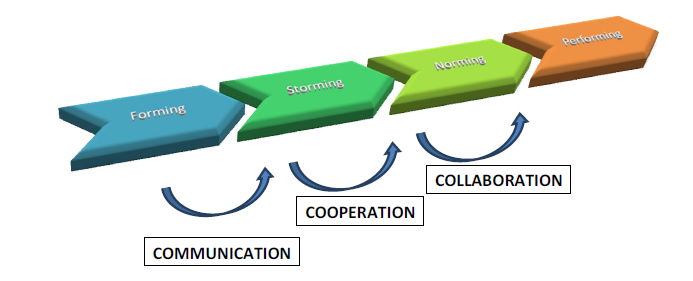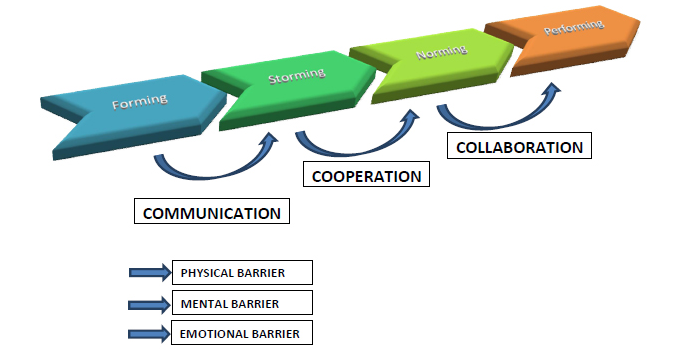A STUDY ON THE CORRELATIONS BETWEEN VARIOUS THEORETICAL FRAMEWORKS
WRITTEN BY: SASI KUMAR
Introduction
This article talks about how the models listed below can be interconnected to build a better understanding of Teambuilding and Leadership in an organization with Bruce Tuckman’s Team Development Model forming the base for these correlations. The models that will be discussed in this paper as follows:
- Tuckman’s Team Development Model
2. 3Cs of Teamwork
3. 3 Communication Barriers
Teambuilding and Leadership are almost becoming a common language across organization around the world, and especially in Singapore, where human resource has found its way in becoming the largest natural resource. Organizations have begun to understand the growing need of teambuilding. It is evident a better team is able to create better outcomes through teamwork. The concerning factor will be that many organization view teambuilding as an ability for the teams to come together to do different things rather than work. On a larger perspective this can be acceptable, but analyzing deeper, teambuilding tends to have more detailing and strategic planning in order to make sure a particular group of people be able to
come together to perform extraordinary cause.
By combining some of the familiar/ common models of teambuilding, organizations will be able to better understand the intricate/ complex details that will need to be highlighted for a better and smooth transition from one phase to another.
Bruce Tuckman’s Team Development Model
This model describes the phases which teams tend to go through from their inception to the successful completion of the project, and highlights the areas which may cause the team and the project to fail.
There are four stages that a team will go through in their path together. These stages are Forming, Storming, Norming and Performing. Tuckman also have mentioned that teams will go through each stage one at a time and will not have a chance to jump stages.
Forming:
High dependence on an individual leader for guidance and direction. Little agreement on team aims other than received from leader. Individual roles and responsibilities are unclear. Leader must be prepared to answer lots of questions about the team’s purpose, objectives and external relationships. Processes are often ignored. Members test tolerance of system and leader
Storming:
Decisions don’t come easily within group. Team members vie for position as they attempt to establish themselves in relation to other team members and the leader, who might receive challenges from team members. Clarity of purpose increases but plenty of uncertainties persist. Cliques and factions form and there may be power struggles. The team needs to be focused on its goals to avoid becoming distracted by relationships and emotional issues. Compromises may be required to enable progress.
Norming:
Agreement and consensus largely forms among the team, who respond well to facilitation by a leader. Roles and responsibilities are clear and accepted. Big decisions are made by group agreement. Smaller decisions may be delegated to individuals or small teams within group. Commitment and unity is strong. The team may engage in fun and social activities. The team discusses and develops its processes and working style. There is general respect for the leader and some of leadership is more shared by the team.
Performing:
The team is more strategically aware; the team knows clearly why it is doing what it is doing. The team has a shared vision and is able to stand on its own feet with no interference or participation from the leader. There is a focus on over-achieving goals, and the team makes most of the decisions against criteria agreed with the leader. The team has a high degree of autonomy. Disagreements occur but now they are resolved within the team positively, and necessary changes to processes and structure are made by the team. The team is able to work towards achieving the goal, and also to attend to relationship, style and process issues along the way. Team members look after each other. The team requires delegated tasks and
projects from the leader. The team does not need to be instructed or assisted. Team members might ask for assistance from the leader with personal and interpersonal development

Relationship between Tuckman’s Team Development Model and 3Cs
The framework 3Cs basically talks about the three important words that a team will have to have in order to work together effectively and efficiently. The three Cs are Communication; Cooperation and Collaboration respectively.

The figure above illustrates how the 3Cs can be combines together with the TUCKMAN’s TEAMBUILDING Model. More people tend to identify and know TUCKMAN’s TEAMBUILDING model that teams will have to move from Forming to Storming, from storming to norming and from norming to performing. They also know that there is no short cut to Performing, and that every team will have to go through these stages. The question that many cannot answer, though, is how can you move from one stage to another?
3Cs tend to answer this question easily, as illustrated by the figure above. Communication will lead a team from Forming to Storming, as disagreement can only be shown through communication, regardless of verbal or non-verbal.
A team will only be able to move from a difficult Storming stage when they start to cooperate with each other. Cooperation as stated in Oxford Dictionary, it is the action or process of working together to the same end. So, cooperation enables a team to put aside their differences and to work together to achieve the common goal.
Lastly, teams can only move on to Performing stage from Norming Stage, when they are able to coordinate flawlessly by understanding each other’s strengths and weaknesses. They tend to focus on the strengths and help each other out with the weaknesses. This collaboration can also be called Synchronization, where team members become “in sync” with each other, they tend to understand each other in a different level.
Relationship between Tuckman’s Team Development Model, 3Cs and 3Barriers.
The 3 communication barriers are the culprit that stops a team or individual from advancing to the next level in their relationship. The three barriers are Physical Barrier, Mental Barrier and Emotional Barrier. These barriers are the reason why Teams cannot move from Forming to Storming stage. Also, without knowing these barriers, teams tend to have a pseudo effect that they have passed the Storming stage and are already into the Norming stage.

Physical Communication Barrier refers to the proximity of a person’s touch to another. This touch can be expressed in a form of a handshake, where meeting a new person and shaking their hands will give a different feeling compared to meeting the same new person and just saying “Hello”. These physical barriers stop us from having any form of contact with a person or team. Some colleagues have broken this physical barrier, they would not mind when a colleague were to come up to them to give them a massage or even comically pull them or hold them. Physical barriers in a FOCUS Adventure programmes can be broken with activities such as, SPA, International Handshake, Alphalink and Turning Point.
Mental Communication Barrier refers to the way two new people come together to solve a problem or a task by thinking together. Many people, when meeting new individuals will try not to show their ability to think as they may feel inferior to the other person. This barrier stops a team from thinking together and moving forward. Teams will need to first break the physical barrier in order to get to break the mental barrier. Mental barriers in FOCUS Adventure programmes can be broken with activities like Loose Change, Key Punch and Tower of Hanoi.
Emotional communication barrier, the final barrier a team will have to break in their Forming stage to move on to the Storming stage. This barrier basically shows a person’s true self during adverse situation. Most of the time, when new people meet, they tend to boast their good aspects/talents in themselves, to make themselves interesting to the other person. During that phase, people tend to be nice, understanding and forgiving. As they break the physical and mental barrier, they will arrive at the emotional barrier. This barrier breaks when a person gets angry with another in a team, cries to a person from the team, shows his/her true excitement, in another words, showing the team their variety of emotions with the
different levels in each.
Once this barrier breaks, teams will automatically move into the Storming stage, as you can only show differences when you reveal your true colours, and make known your emotions to the public/ common man.
Conclusion
As a conclusion, the figure above illustrates
- what are the different stages a team goes through during their lifetime together, working
2. How can a team move from one stage to another?
3. Lastly, how can a team move out from the most difficult stage, forming?
This figure is done with an assumption that every member in the team is willing to work together and have understood that it takes a team to make something impossible to incredible.
With this comparison, Facilitators and Participants can have a better idea and bigger picture on TUCKMAN’S TEAMBUILDING model and how this can be incorporated into their working environment.







